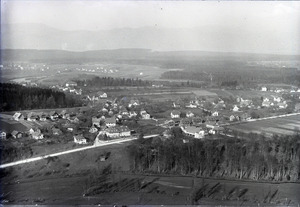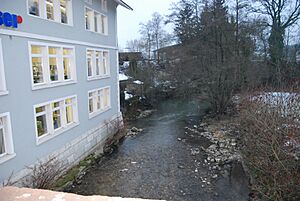Wynau facts for kids
Quick facts for kids
Wynau
|
||
|---|---|---|

Wynau village
|
||
|
||
| Country | Switzerland | |
| Canton | Bern | |
| District | Oberaargau | |
| Area | ||
| • Total | 5.07 km2 (1.96 sq mi) | |
| Elevation | 414 m (1,358 ft) | |
| Population
(Dec 2020 )
|
||
| • Total | 1,624 | |
| • Density | 320.3/km2 (829.6/sq mi) | |
| Postal code |
4923
|
|
| Surrounded by | Aarwangen, Murgenthal (AG), Roggwil, Schwarzhäusern, Wolfwil (SO) | |
Wynau is a small town, also called a municipality, located in the Oberaargau area of the canton of Bern in Switzerland. It's a place with a long history and a mix of nature and modern life.
Contents
Wynau's History: From Ancient Times to Today
Wynau was first written about in the year 1201. Back then, it was called Wimenouwe.
Early Settlements and Roman Times
People lived in Wynau a very long time ago. We know this because of things found from the Bronze Age near the Aare river. There are also remains of a Roman villa, a large country house, at a place called Hoferrain-Birchi. A Roman ship with a rudder was even found in the Aare river. Old graves, possibly from the Middle Ages, have also been discovered.
Who Owned Wynau?
In the 1200s and 1300s, powerful families and nobles owned most of the land in Wynau. These included the Lords of Bechburg and the Counts of Falkenstein. Over time, a religious group called St. Urban's Abbey bought land from these nobles.
In 1406, the city of Bern started to gain control in the area. By 1413, Bern made a deal with St. Urban's Abbey. This agreement brought Wynau and the nearby Murgenthal valley under Bern's control.
Changes in Government
Later, in 1798, the French army invaded Switzerland. Wynau became part of the Langenthal district under a new government called the Helvetic Republic. When this government ended in 1803, Wynau moved to the Aarwangen district.
The Old Church of St. Mauritius
The church of St. Mauritius was first mentioned in 1201. This church is very old, probably built between the 900s and 1000s. It was built on top of an even older building. The church was made bigger around 1270–1280. For many years, it was an important religious center for Wynau and several nearby villages.
Wynau's Economy and Development
In the 1700s, people in Wynau started making cotton and mining coal. This helped the local economy alongside farming. After 1800, many farms changed from growing crops to raising dairy cows and other animals.
In 1862, a railroad line opened, connecting Wynau to larger cities. However, not many big businesses came to Wynau. Many people from Wynau still travel to nearby towns like Langenthal and Roggwil for work.
An important power station was built on the Aare river between 1894 and 1896. Wynau later bought this power station in 1903. It was updated between 1992 and 1996.
Wynau's Geography: Rivers, Forests, and Homes
Wynau covers an area of about 5.1 square kilometers (2 square miles). A large part of this land is used for farming, about 37.5%. Forests cover another big part, about 39.9%.
How Wynau's Land is Used
About 17.9% of Wynau's land is built up with buildings and roads. This includes houses (8.3%) and transportation areas (3.9%). Power plants and other special areas make up 3.7%.
Most of the forested land is dense forest (38.3%). A small part has orchards or small groups of trees (1.6%). For farming, 27.3% of the land grows crops. Another 7.3% is used for pastures, where animals graze. About 2.9% is for orchards or vineyards. All the water in Wynau is from flowing rivers.
Location and Parts of Wynau
Wynau is located between two rivers, the Aare and the Murg. It also sits near some hills called the Höchi. The municipality includes different parts like Dorf, Ägerten, Hubel, Birch, and Einschlag. There are also smaller villages called Ober-Wynau and Ober-Murgenthal.
Administrative Changes
Wynau used to be part of the Aarwangen district. But on January 1, 2010, it joined a new administrative area called Verwaltungskreis Oberaargau.
Wynau's Coat of Arms
The blazon of Wynau's coat of arms shows a blue grape with green leaves on a silver background. This design might be a "canting arm." This means the picture on the coat of arms sounds like the name of the place. "Wein" is the German word for wine, which sounds similar to "Wynau."
People of Wynau: Demographics and Languages
Wynau has a population of about 1,600 people. Around 17% of the people living in Wynau are from other countries.
Languages Spoken
Most people in Wynau speak German as their main language. About 89.4% of the population speaks German. The second most common language is Albanian, spoken by about 4.2% of people. Italian is the third most common, spoken by about 2.2%.
Where People Come From
In 2000, about 29.4% of Wynau's residents were born there. Another 30.6% were born in the same canton (Bern). About 22.7% were born elsewhere in Switzerland, and 14.5% were born outside of Switzerland.
Age Groups
Children and teenagers (ages 0–19) make up about 18% of Wynau's population. Adults (ages 20–64) are the largest group, at 64.2%. Seniors (over 64 years old) make up 17.9%.
Population Over Time
The chart below shows how Wynau's population has changed over many years:

Important Buildings: Heritage Sites
Some buildings in Wynau are very important because of their history and culture. They are listed as heritage sites of national significance. These include the rectory (a house for a church leader), the Swiss Reformed church, and the Speicherstöckli.
Wynau's Economy: How People Work
Wynau has a mix of jobs in different areas. In 2011, the unemployment rate was 3.46%.
The Power Station
Between 1894 and 1896, the first hydroelectric power station on the Aare river was built in Wynau. It was built by a German company. In 1903, the power station was sold to Langenthal and other nearby towns, including Wynau. Only then did Wynau start buying electricity from the station in its own area. The dam and power plant were completely rebuilt between 1992 and 1996.
Types of Jobs
In 2008, there were 490 people working in Wynau. These jobs are divided into three main types:
- Primary sector: This includes jobs that get raw materials from nature. In Wynau, this means farming. About 45 people worked in this sector.
- Secondary sector: These jobs involve making things. This includes manufacturing and construction. About 149 people worked in this sector.
- Tertiary sector: These jobs provide services. This includes things like sales, transportation, hotels, education, and healthcare. About 296 people worked in this sector.
Many people who live in Wynau travel to other towns for work. In 2000, 585 people left Wynau to work elsewhere, while 202 people came into Wynau for work. Most people (60.8%) used a private car to get to work, while 10.4% used public transportation.
Religion in Wynau
Based on information from 2000, about 62.2% of Wynau's population belonged to the Swiss Reformed Church. About 15.2% were Roman Catholic. Other groups included Albanian Christians and Muslims. Some people did not belong to any church.
Education in Wynau
In Wynau, many adults have completed higher education. About 38.3% of the population finished non-mandatory high school. Another 8.5% went on to university or a specialized college.
The School System
The school system in the Canton of Bern works like this:
- One year of optional Kindergarten.
- Six years of Primary school.
- Three years of mandatory lower Secondary school. Students are grouped by their abilities.
After lower Secondary school, students can continue their education or start an apprenticeship (learning a trade on the job).
In the 2009–2010 school year, 128 students attended schools in Wynau. There was one kindergarten class with 24 students. Wynau had four primary classes with 87 students. There were also two lower secondary classes with 17 students. Many students in Wynau's schools were from other countries or spoke a different language at home.
Some students from Wynau go to school in other towns, and some students from other towns come to school in Wynau.
Wynau's Climate
Wynau has a moderate climate. Here's a look at the average weather:
| Climate data for Wynau (1991–2020) | |||||||||||||
|---|---|---|---|---|---|---|---|---|---|---|---|---|---|
| Month | Jan | Feb | Mar | Apr | May | Jun | Jul | Aug | Sep | Oct | Nov | Dec | Year |
| Mean daily maximum °C (°F) | 3.4 (38.1) |
5.5 (41.9) |
10.8 (51.4) |
15.3 (59.5) |
19.5 (67.1) |
23.3 (73.9) |
25.2 (77.4) |
24.8 (76.6) |
20.0 (68.0) |
14.2 (57.6) |
7.7 (45.9) |
3.8 (38.8) |
14.5 (58.1) |
| Daily mean °C (°F) | 0.7 (33.3) |
1.3 (34.3) |
5.2 (41.4) |
9.2 (48.6) |
13.5 (56.3) |
17.3 (63.1) |
19.0 (66.2) |
18.4 (65.1) |
14.2 (57.6) |
9.7 (49.5) |
4.6 (40.3) |
1.5 (34.7) |
9.6 (49.3) |
| Mean daily minimum °C (°F) | −2.2 (28.0) |
−2.5 (27.5) |
0.2 (32.4) |
3.3 (37.9) |
7.8 (46.0) |
11.6 (52.9) |
13.3 (55.9) |
13.1 (55.6) |
9.5 (49.1) |
6.1 (43.0) |
1.7 (35.1) |
−1.1 (30.0) |
5.1 (41.2) |
| Average precipitation mm (inches) | 83 (3.3) |
67 (2.6) |
74 (2.9) |
76 (3.0) |
110 (4.3) |
103 (4.1) |
117 (4.6) |
115 (4.5) |
90 (3.5) |
90 (3.5) |
82 (3.2) |
101 (4.0) |
1,107 (43.6) |
| Average precipitation days (≥ 1.0 mm) | 10.2 | 9.3 | 9.8 | 9.8 | 12.2 | 10.9 | 11.1 | 11.3 | 9.2 | 10.5 | 10.5 | 11.6 | 126.4 |
| Average relative humidity (%) | 86 | 82 | 77 | 73 | 75 | 74 | 74 | 78 | 82 | 87 | 88 | 88 | 80 |
| Mean monthly sunshine hours | 39 | 76 | 134 | 170 | 192 | 219 | 240 | 214 | 153 | 90 | 41 | 29 | 1,596 |
| Percent possible sunshine | 17 | 30 | 40 | 45 | 44 | 49 | 54 | 53 | 45 | 31 | 18 | 14 | 40 |
| Source: MeteoSwiss | |||||||||||||
See also
 In Spanish: Wynau para niños
In Spanish: Wynau para niños









